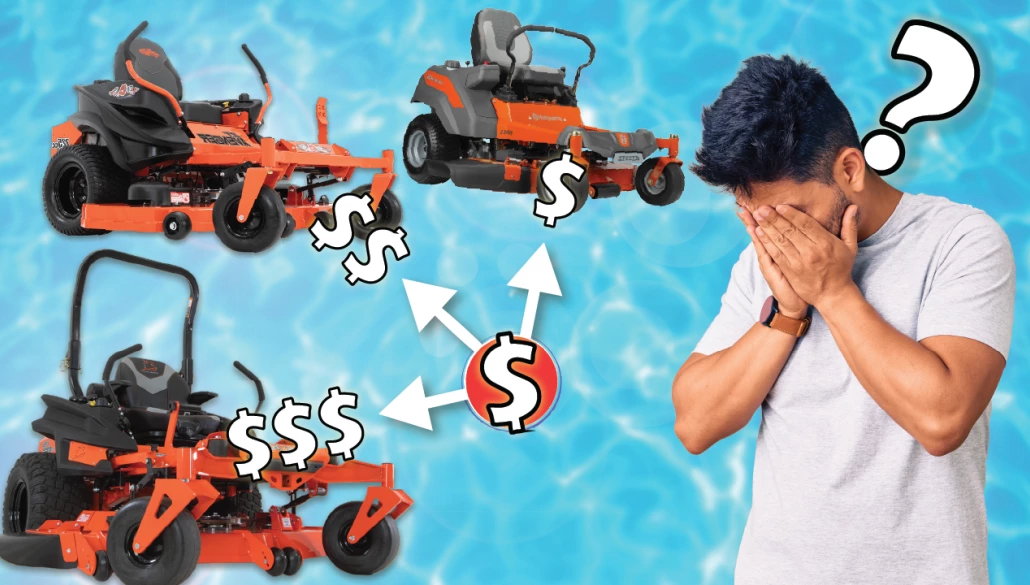Have you ever wondered why some lawnmowers last longer than others? What problems do consumers run into regarding maintenance and repair on their mowers?
Usage
There are two main types of zero-turn mowers:
Residential mowers are typically used for personal use on smaller lawns, while commercial mowers are used for more heavy-duty tasks, such as mowing large properties or parks.
Homeowners typically mow 20 to 30 times a year. The difference depends on their location and how much rainfall they receive.
Most homeowners spend one to four hours mowing their yard at each cut. The time difference depends on the yard size and your zero-turn mower's performance. The average homeowner will put between 20 and 120 hours on their zero-turn mower annually.
Many consumers are putting in even more hours than that on their mowers.
Commercial lawn companies will likely put in between 350 to 950 hours on a zero-turn mower yearly.
The focus of this article is on the homeowner.
Lifespan
There are three ways you can project the lifespan of a zero-turn mower.
(1) The first lifespan projection can come from a mower’s age. Residential mowers, on average, can last between 5 to 9 years with proper maintenance. (Commercial zero-turn mowers typically last between 8 to 12 years.)
Of course, your zero-turn mower could die out more quickly or even last much longer, depending on how often you use it, how well you maintain it, and where it's stored when you're not using it.
(2) The second projected measurement influence is where the mower is stored. A mower kept outside and exposed to the rain and other elements will not last as long as one sheltered.
An unprotected mower will require more repair work than if you kept your mower inside a shed or garage with a mower cover on.
(3) Running Hours is the third way to project a mower’s lifespan. Most mowers have an hour meter. However, some of the least expensive residential mowers might not have an hour meter.
Residential mowers, on average, will last between 500 to 1,500 hours. On the other hand, commercial zero turns typically last between 1000 - 3500 hours.
Long Hours = Poor Performance?
Mowers can often last longer than a projected lifespan. It is important to remember that older mowers with increased life span and hours can come up short with decreased overall cut quality and efficiency.
You will notice a difference at over 1000 hours on your zero-turn mower in the way the mower drives and cuts. These events will become apparent.
- The deck is a little looser and sloppier.
- The control arms are also a bit loose.
- The mower used to be more responsive.
- The seat will be broken and less comfortable than when it was new.
These are all things that can be fixed by replacing parts and tightening up bolts. However, the point you should take away is that a used mower with over 1000 hours will cut less well and feel more comfortable than a new mower. Please remember these details if you’re buying a used mower for over 500 hours. It is recommended that your search stay below 500 hours.
Quality
Another thing to keep in mind is the quality of the mower. When it comes to residential mowers, you can find some great options at an affordable price. Some quality brands we carry at Tractor Bob include Bad Boy, Altoz, and Husqvarna.
Here are some essential routine steps to keep your mower going for a long time.
Top Ways to Extend Your Mower's Life
The top habits to extend the life of your zero-turn mower are:
- Routine cleaning and maintenance.
- Keeping the blades sharp.
- Keeping the mower stored well.
- Monitoring tire pressure and condition.
- Winterizing your mower
Routine Cleaning and Maintenance
Regular cleaning and maintenance are crucial for preventing breakdowns and maximizing the lifespan of your zero-turn mower. These are steps to follow when cleaning and maintaining your mower.
- Pre-Start
- Take the time to examine the batteries, belts, bearings, hoses, hydro systems, and spindles, paying close attention to any unusual sounds when starting the mower.
- Make sure to maintain consistent tire pressure as recommended in your manual. (Inadequate tire pressure can affect the mower's performance and lead to uneven cutting.)
- Check that the engine runs smoothly and that you use the correct fuel type.
- Post-Cutting
- Inspect the mower to identify any potential maintenance issues before they cause significant problems.
- Grass clippings and debris can accumulate on the mower, especially on the underside of the deck.
- Take the time to clean the mower thoroughly, paying close attention to the underside of the deck to prevent grass build-up.
- One of the critical factors in achieving a clean and precise cut is using sharp blades. Dull blades can damage the grass, resulting in torn and uneven cuts. Regularly inspect your blades for signs of wear or damage. Remove the blades, clean them, and sharpen their edges if necessary. Consult your local dealer for specific tips and tricks relevant to your region.
Transmission Care
The transmission is a critical component of your zero-turn mower. Over time, heat exposure can lead to sludge and varnish formation, ultimately degrading performance and causing rough operation.
Changing the transmission oil according to the manufacturer's recommendations is essential to ensure a mower's smooth operation.
Proper Storage
Proper storage is vital to preserving the lifespan of your zero-turn mower. We have already discussed the importance of protected shelter to extend a mower’s life. Moisture can be particularly damaging, leading to rust and corrosion. Keep the mower covered to shield it from the sun and prevent water from settling.
Before storing your mower for the winter or an extended period:
- Clean it thoroughly from top to bottom. (This deep cleaning session allows you to inspect the mower for any signs of damage or leaks.)
- Additionally, consider adding a fuel stabilizer to the tank to prevent water and gasoline separation, which can cause corrosion and damage internal engine parts.
- It's essential to remove any contaminants from the engine by flushing out old oil and replacing it with premium synthetic motor oils.
- Before starting your mower again in the spring, consider scheduling an inspection with your local dealer. Their service technicians can ensure everything works correctly, minimizing potential issues at the start of the new season.
Monitoring Tire Pressure
Maintaining proper tire pressure is essential for the longevity of your zero-turn mower and its components. Incorrect tire pressure can result in an uneven cut and cause strain on the mower's deck.
Make it a habit to check and adjust tire pressure regularly, following the manufacturer's recommendations. By keeping tire pressure consistent, you'll prolong the life of your equipment and ensure optimal performance.
Summary
The lifespan of your zero-turn mower can vary greatly depending on usage, maintenance, and quality. You can ensure your zero-turn mower lasts as long as possible by:
- Following the manufacturer's recommended maintenance schedule.
- Using the mower following the owner’s manual.
- Investing in a high-quality model.
Tractor Bob is committed to helping buyers find the right solution for their power equipment needs. You can also learn more about using your power equipment on this site.
Reach out to one of Tractor Bob’s mower experts to select a machine that fits your needs.






![YouTube Thumbnails [Recovered]-04](https://www.tractorbob.com/asset/69127047769a7/YouTube-Thumbnails-%5BRecovered%5D-04.png?w=1030&h=585&fit=crop&fm=webp)

